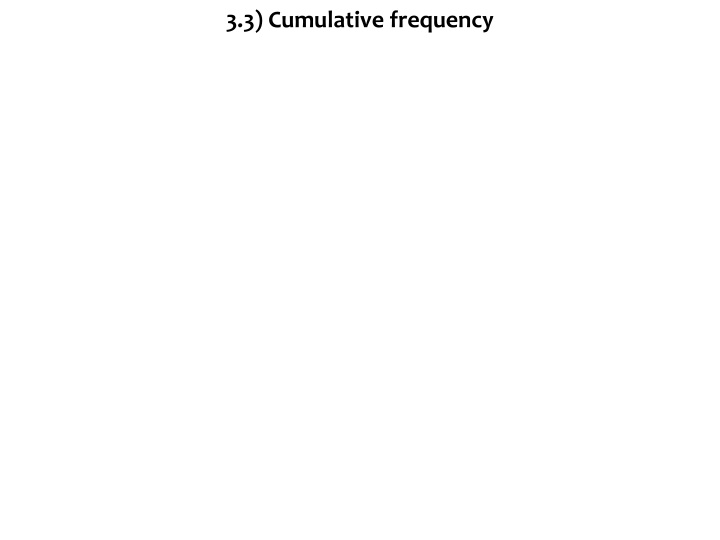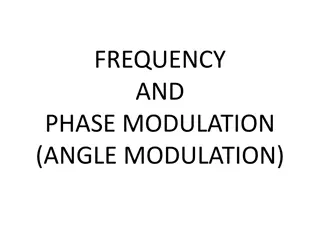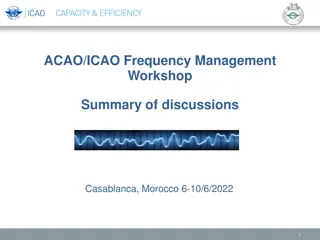
Cumulative Frequency Diagrams
Learn how to draw and interpret cumulative frequency diagrams using real data on time and frequency. Practice estimating quartiles, percentiles, interquartile range, and more using the diagrams. Enhance your statistical analysis skills in a practical way.
Download Presentation

Please find below an Image/Link to download the presentation.
The content on the website is provided AS IS for your information and personal use only. It may not be sold, licensed, or shared on other websites without obtaining consent from the author. If you encounter any issues during the download, it is possible that the publisher has removed the file from their server.
You are allowed to download the files provided on this website for personal or commercial use, subject to the condition that they are used lawfully. All files are the property of their respective owners.
The content on the website is provided AS IS for your information and personal use only. It may not be sold, licensed, or shared on other websites without obtaining consent from the author.
E N D
Presentation Transcript
Your turn Worked example Draw a cumulative frequency diagram for the data: Draw a cumulative frequency diagram for the data: Time (s) Frequenc y Time (s) Frequency 9.6 < ? 9.7 1 9.6 < ? 9.8 3 9.7 < ? 9.9 4 9.8 < ? 10.05 7 9.9 < ? 10.05 10 10.05 < ? 10.15 8 10.05 < ? 10.2 17 10.15 < ? 10.2 14 Diagrams/Graphs used with permission from DrFrostMaths: https://www.drfrostmaths.com/
Your turn Worked example Use the cumulative frequency diagram to estimate the: Use the cumulative frequency diagram to estimate the: a) Lower quartile b) Median c) Upper quartile d) 90th percentile a) Lower quartile b) Median c) Upper quartile d) 60th percentile 9.95 s 10.07 s 10.13 s 10.17 s Questions used with permission from Corbettmaths (https://corbettmaths.com/) and Drfrostmaths (https://www.drfrostmaths.com/)
Your turn Worked example Use the cumulative frequency diagram to estimate the: Use the cumulative frequency diagram to estimate the: a) Interquartile range b) 20th 80th interpercentile range a) Interquartile range b) 10th 90th interpercentile range 0.18 s 0.21 s Questions used with permission from Corbettmaths (https://corbettmaths.com/) and Drfrostmaths (https://www.drfrostmaths.com/)
Your turn Worked example Use the cumulative frequency diagram to estimate the number of runners who had a time less than 10.15 seconds. Use the cumulative frequency diagram to estimate the number of students who achieved fewer than 23 marks. 26 Questions used with permission from Corbettmaths (https://corbettmaths.com/) and Drfrostmaths (https://www.drfrostmaths.com/)
Your turn Worked example Use the cumulative frequency diagram to estimate the number of runners who had a time greater than 9.95 seconds. Use the cumulative frequency diagram to estimate the number of students who achieved more than 12 marks. 24 Questions used with permission from Corbettmaths (https://corbettmaths.com/) and Drfrostmaths (https://www.drfrostmaths.com/)
Your turn Worked example Use the cumulative frequency diagram to estimate the number of runners who had a time between 9.8 and 10 seconds. Use the cumulative frequency diagram to estimate the number of students who achieved between 7 and 21 marks. 8 Questions used with permission from Corbettmaths (https://corbettmaths.com/) and Drfrostmaths (https://www.drfrostmaths.com/)
Your turn Worked example Use the cumulative frequency diagram to draw a box plot: Use the cumulative frequency diagram to draw a box plot: Questions used with permission from Corbettmaths: https://corbettmaths.com/






















